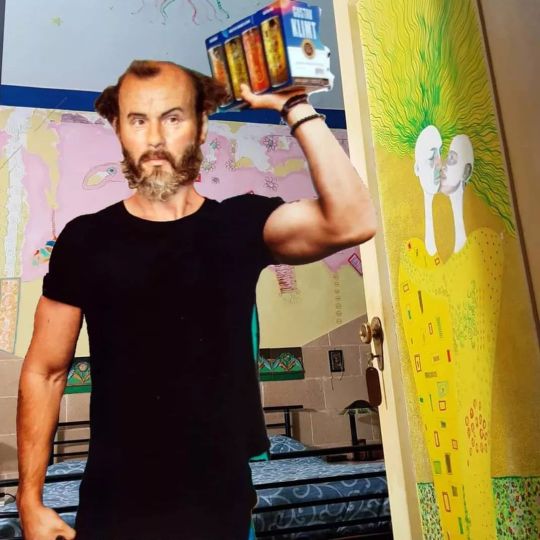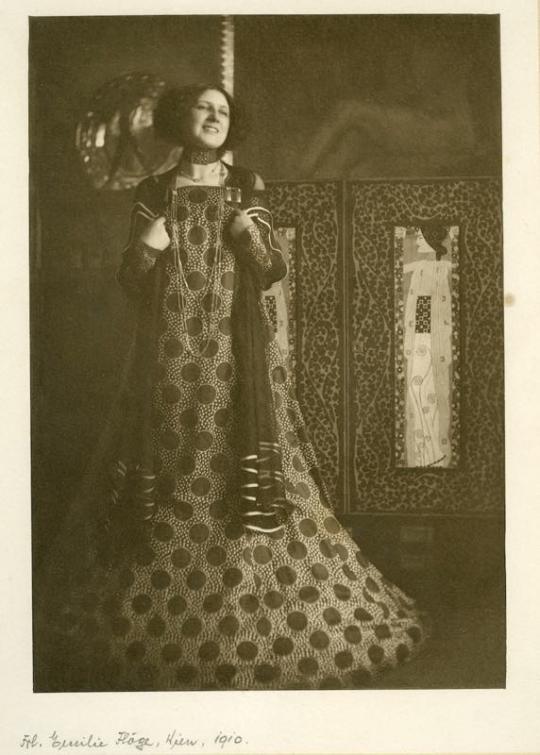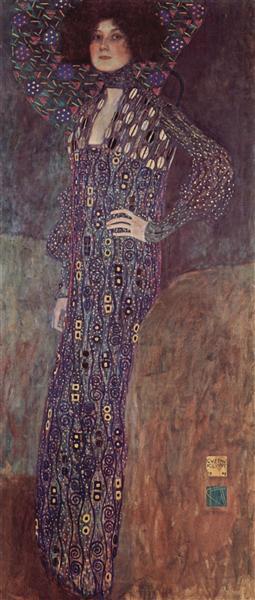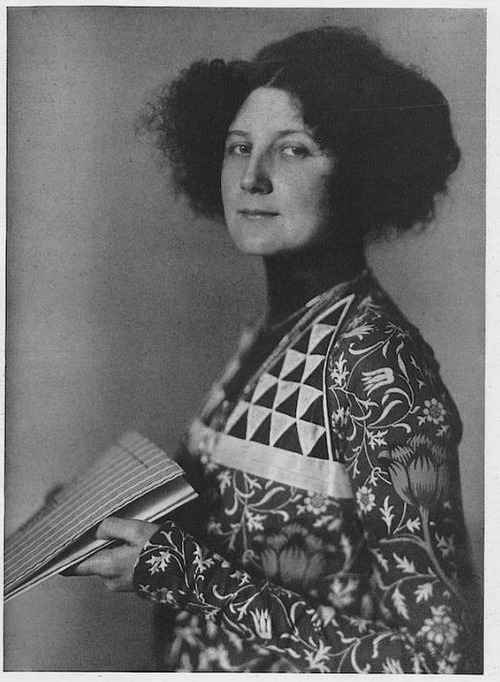#Emile Floge
Photo

Klimt e il famoso “Bacio” de La Casa degli Artisti …e si era diffusa la voce che la nostra stanza, quella mia e di Cristina, era dedicata a Klimt. E tutti andavano dicendo che il Bacio raffigurato sulla porta con le effigi mia e di Cristina era più romantico dell’originale. Fu così che il grande Gustav s’incuriosì e arrivò senza preavviso. Rimase contrariato perché Cristina ed io non gli permettemmo di dormire nella stanza Klimt. A nessuno mai avevamo concesso la nostra stanza e quindi neanche a lui. Gli concedemmo però di visitarla. Rimase estasiato dai colori e dai ghirigori sui muri, dalle installazioni nei vari angoli che pazientemente avevo creato nel corso degli anni e soprattutto ammirò in riverente silenzio il famoso Bacio che io avevo riprodotto sulla porta. Guardava e sorrideva: era soddisfatto della mia interpretazione. In tanti avevano parlato della sua opera e avevano cercato di copiarla, tanti bla bla bla inutili e senza senso. Io, invece, con poche pennellate e un insospettato montaggio fotografico ero riuscito a carpire il messaggio più recondito della sua opera e a trasmetterlo a tutti coloro che avessero guardato con attenzione. Lui aveva dedicato quest’opera a Emile Floge, la donna più importante della sua vita per la quale aveva nutrito un profondo sentimento d’amore. Pensava di essere l’unico al mondo, ma guardando la mia riproduzione dovette ricredersi. Esistevano nella storia altre coppie inseparabili, nonostante tutto, eppure lui si era separato tante volte da Emile per rincorrere stupide chimere… Si rese conto comunque dell’atmosfera magica che si respirava nella Casa degli Artisti e cominciò a rilassarsi. Finalmente sorrise e si diede da fare per godere a fondo della cultura, dell’arte e…della gastronomia salentina. Fu la vacanza perfetta che non avrebbe mai immaginato. Se ne andò dopo una decina di giorni. Fu dopo la sua partenza che scoprii sulla nostra porta la sua firma accanto alla mia…gioia infinita! Il più grande regalo che Gustav potesse farmi! See you next week! Tutte le storie de La Casa degli Artisti : https://storiedautore.blogspot.com/ (presso La Casa Degli Artisti) https://www.instagram.com/p/CeeP1nEKUSC/?igshid=NGJjMDIxMWI=
0 notes
Photo

Arthur Benda, Atelier d’Ora, Portrait of Emilie Flöge, ca. 1909
#photography#Arthur Benda#Atelier d'Ora#vintage photographs#photographic portrait#Emilie Flöge#Emile Floge
191 notes
·
View notes
Photo

By Alan Shepard, done at Soy Feliz Studio, Mexico City. http://ttoo.co/p/25633
#forearm tattoo#illustrative tattoo#contemporary tattoos#art tattoos#gustav klimt tattoos#portrait of emile floge tattoos#medium size tattoos#alanshepard#tattoo art#art#tattoos#tattoo#ifttt
6 notes
·
View notes
Text
Emilie Flöge
https://www.unadonnalgiorno.it/emilie-floge/

Emilie Flöge, designer e stilista viennese che ha dettato la moda agli inizi del novecento. Ha diretto con le due sorelle un importante atelier per 34 anni. Ha anche ispirato vari quadri di Gustav Klimt e di altri artisti della Secessione.
Nacque a Vienna il 30 agosto del 1874 da una famiglia della media borghesia. Cominciò a lavorare come sarta da giovanissima, raggiungendo alti livelli di fantasia e originalità che la portarono a affermarsi nel panorama dell’altra moda austriaca degli inizi del XX secolo. Aveva vinto anche un importante concorso che l’aveva portata a disegnare, con la sorella, un pezzo per una mostra prestigiosa. Nel 1890, la sorella Helene sposò Ernst Klimt. Un anno dopo, il giovane morì e il fratello Gustav, già affermato artista, divenne esecutore testamentario e tutore della nipote, ancora in fasce. Ebbe quindi modo di vivere molto casa Flöge dove iniziò a frequentare la diciassettenne Emilie che divenne una sua grande fonte di ispirazione e sua modella in varie occasioni.
Nel 1902 le ha dedicato Ritratto di Emile Flöge il suo primo dipinto nel quale compare la tipologia della “donna-gioiello”. Il quadro non venne apprezzato dalla famiglia della giovane e nel 1908 fu acquistato dalla città di Vienna. Diversi critici affermano che Flöge sia anche la donna inginocchiata ne Il bacio.
Nel 1904, la giovane aprì, con le due sorelle, il Salon Schwester Flöge nella capitale austriaca che divenne un faro nel mondo della moda attraendo tutte le clienti più altolocate della città arrivando a dare lavoro a circa 80 impiegati/e. Nel loro negozio, progettato da Josef Hoffmann, autore anche dello studio di Klimt, tra abiti larghi dalle fantasie colorate, trovavano posto anche affascinanti oggetti d’arte. C’erano sedie geometriche, tavoli a scacchi bianchi e neri che abitavano spazi rivestiti con moquette sottili e delicate. Avevano anche un logo dedicato. Come Klimt, con il suo stile provocatorio e l’arte per l’epoca giudicata “erotica”, Emilie Flöge aveva voglia di creare qualcosa di rivoluzionario nel mondo della moda. Molti dei suoi abiti venivano indossati senza corsetto (una rarità per l’epoca), e pendevano larghi dalle spalle con ampie maniche.
Lo stesso artista partecipava con ardore all’attività creativa dell’atelier, gli abiti erano spesso il risultato di un lavoro a quattro mani.
I due ebbero un’intensa e profonda relazione umana, artistica e culturale, anche se il pittore la tradì spesso. Non vissero mai insieme, ma è noto che furono compagni nella vita pubblica e privata. Alla morte di Klimt, nel 1918, fu lei a curarne il lascito testamentario.
Il grande bagliore acceso dai riflettori puntati sul suo compagno non hanno reso giustizia al suo lavoro. Quando Coco Chanel apriva il suo salone a Parigi nel 1910, Emilie Flöge confezionava abiti all’avanguardia già da diversi anni. Modelli a vita impero, maniche larghe e creazioni dettagliate ispirate ai ricami ungheresi e slavi. Le sue proposte segnavano un netto distacco dall’abbigliamento femminile dell’epoca. La sua idea di libertà si rispecchiava in un guardaroba morbido e rilassato, che evitava i corpetti costrittivi preferendo tagli facili da indossare, simili ai già diffusi abiti a grembiule e ai più moderni caftani, gli stessi che il pittore amava vestire quando dipingeva.
Emilie Flöge prediligeva silhouette giocose e fluttuanti, utilizzava stampe floreali e giochi cromatici metallici di ispirazione orientale, celebrando la libertà fisica, l’espressione di sé, la vicinanza alla natura e la vitalità di altre etnie. A guardare i ritratti della coppia, al tempo, col loro particolare abbigliamento, potrebbero sembrare due hippie degli anni ’70.
L’attività imprenditoriale della designer entrò in crisi nel 1938 con l’annessione dell’Austria alla Germania di Hitler. Le facoltose clienti ebree fuggirono all’estero, ma, pur chiudendo il negozio, continuò a lavorare da casa, proseguendo la creazione della sua moda libera e appassionata.
Alla fine della guerra un incendio distrusse la sua casa, comprese le sue collezioni e gli oggetti che aveva ereditato da Gustav Klimt. Emilie Flöge morì il 26 maggio 1952.
I suoi disegni, influenzati dai primi vagiti dei movimenti femministi, che di lì a poco avrebbero infiammato l’Europa, e le sue idee innovative continuano a influenzare gli stili di moda delle odierne passerelle.

1 note
·
View note
Photo

The Kiss Gustav Klimt
Alternative name: The Kiss (Klimt)
Date: 1907 - 1908
Style: Art Nouveau (Modern)
Period: Golden phase
Media: oil, canvas
Dimensions: 180 x 180 cm
Vienna, Austria
The Kiss is probably Gustav Klimt’s most famous work. It is also the high point of the artist’s Gold Period, which was characterized by his use of gold leaf in his work.
This painting is one in which Klimt deviated from his portrayal of dominant in women in the form of a femme fatale.
Instead is the portrayal of love and art, a couple locked in a golden-flecked, flower-filled embrace. Klimt was a man with an unbridled sexual appetite, as he fathered at least 14 illegitimate children.
It is rumored that Klimt and his longtime companion, Emile Floge, who was also said to be his lover, were the models of the painting, which was selected to be printed on the Austrian 100 euro coin, minted in 2003.
0 notes
Text
The Life and Paintings of the Famous Austrian Painter Gustav Klimt
Gustav Klimt was born July 14 1862 in Austria. He was an symbolist painter from Austria. He was also a part of the Vienna Secessionist Movement. Mostly he did paintings, murals and many sketches. He also created many art objects using gold leaves that gave him a touch of distinction. He was hugely intrigued by the female body that got betrayed through many of his paintings and for that he was often castigated and ridiculed.
Gustav Klimt was born in a place called Baumgarten situated near Vienna. He had two brothers and four sisters. Both the brothers were gifted artists including Gustav. His father Ernst Klimt was a gold engraver by profession. He had migrated from Bohemia and married Anna Klimt. Anna nursed a desire to be a singer. Klimt spent his so many years of childhood in abject poverty because those times were different with scarce work and not much economic activity.
Gustav Klimt was awarded a scholarship in 1876 by dint of which he went to study in the Vienna School of Art and Craft. In that school he learnt the tricks of Architectural Painting that he liked immensely. Hans Makart, a history painter of that time, was Klimt’s idol. He began following the conservative school of painting to begin with, which later took an entirely different course. Later his brother Ernst too joined him as a painter, and he too was a good one.
Painting
Gustav Klimt himself, his brother Ernst and Franz Matschz began painting together. They were commissioned work as a team. They called themselves ‘Company of Artists’. They painted for the museum of Vienna. Klimt received Golden order of Merit from the emperor for his mural work in Vienna. He was made honorary member of University of Vienna. Emile Floge was his female companion throughout for which he was looked upon with suspicion by many. It was never clear if he had any sexual relation with her. In 1894 he was commissioned to paint the ceiling of the great hall of the University of Vienna. They were three paintings: philosophy, jurisprudence and medicine. The theme of these paintings was considered to be pornographic. There was a public outcry from all quarters against those paintings, so consequently those murals were to be removed. Klimt’s language of painting was overtly sexual because that’s what he intended them to be when he transformed the traditional themes based on allegory and symbolism. Those three paintings were later destroyed by the German soldiers. His other painting Nuda Verita was again an overtly sexual one. The painting depicted a starkly naked red-headed woman holding the ‘mirror of truth’.
Gustav Klimt used to say that “You should not try to please all.” And that remained his philosophy, and that philosophy gave him the strength to paint the way he wished to paint. In 1902, he painted Beethoven. It was displayed in the secessionist exhibition of Vienna. He painted many landscapes too whenever he went on an outing. Klimt liked to paint figures and he continued with that. He painted near the shores of Attersee from which he too inspiration for many of his landscapes.
Gustav Klimt used gold leaf profusely in many of his works. For this he received positive appreciation and praise from all corners. Portrait of Adele bore a good testimony of Klimt’s penchant for gold leaf.
His main paintings were: Judith and the head of Holofernes, The three ages of woman, Hope, Avenue in Schloss, The friends, etc.
His painting named Death and Life received first prize in a world competition held in Rome. His mother Anna died in 1915, and Klimt died in 1908 after he suffered from acute pneumonia that turned out to be an epidemic. He couldn’t finish many of his paintings.
Klimt mostly relaxed at home wearing only a long robe, a pair of sandals and no undergarments. Usually he didn’t associate with people in the cafes or marketplace. He had lived a cloistered life mostly remaining with his family and his art. When he painted subjects, his models had to sit for long hours because he had a lengthy way of painting his portraits. He didn’t write much about his work or anything, neither did he keep any diary. From his few writings it’s clear that he was not interested in self-portraits because he would argue that he was not an interesting subject for painting. So, in a way, he was self-effacing, unlike many artists of his time or after. He wanted sincerely to express himself, the way he was including his strengths and weaknesses, through his paintings only. This could be one of the major reasons why he never was very serious about creating his own portrait, though he could have done it and it could have been popular and could have fetched a good amount for him.
from JournalsLINE http://journalsline.com/2017/06/15/the-life-and-paintings-of-the-famous-austrian-painter-gustav-klimt/
from Journals LINE https://journalsline.tumblr.com/post/161854981205
0 notes
Photo

Ritratto di Emile floge, Gustave Klimt, olio su tela, 1902, Vienna museum
0 notes
